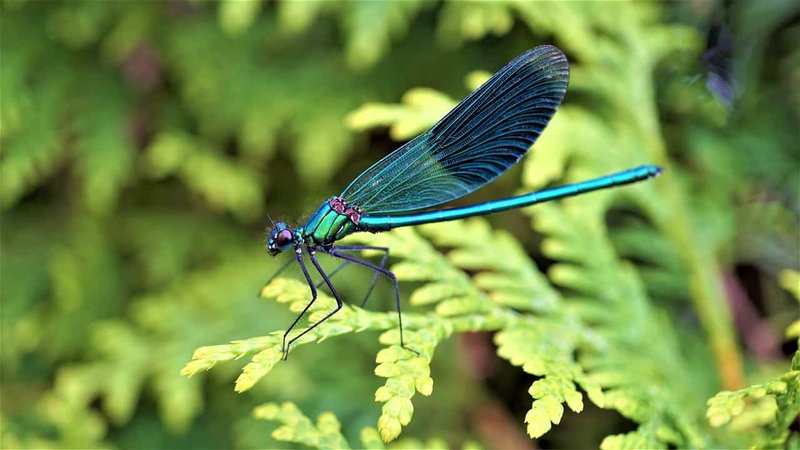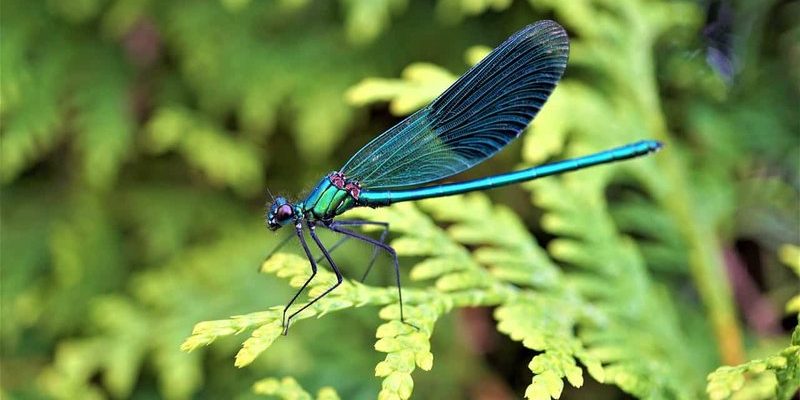
When you start digging, you’ll find that dragonflies have a captivating history and play significant roles in their ecosystems. Today, let’s explore ten intriguing facts about these winged wonders that will surely deepen your appreciation for them. From their astonishing abilities to their lifecycle, there’s a lot to learn about these little marvels!
1. Dragonflies Are Ancient Creatures
Here’s the thing: dragonflies have been around for a really long time. They first appeared on Earth over 300 million years ago, during the Carboniferous period. That makes them older than dinosaurs! Picture this: while dinosaurs were roaming the planet, dragonflies were already flapping their wings.
Back then, some dragonfly relatives were massive, with wingspans reaching up to two feet! Can you imagine encountering a dragonfly that size today? Luckily, those giant relatives died out, but modern dragonflies still carry remnants of that ancient lineage in their remarkable flight abilities and striking appearances.
2. They Are Incredible Flyers
If you’ve ever tried to catch a dragonfly, you know they can be incredibly tricky to pin down. This is mostly due to their superb flying skills. Dragonflies can fly in any direction—up, down, backward, and even hover in place.
They achieve this by using their four wings independently. One pair can go fast while the other pair can slow down. It’s like having a jet plane and a helicopter working together! Imagine being able to change direction mid-air without losing speed. This agility makes them amazing hunters, able to catch prey on the fly, literally!
3. They’re Master Predators
You might be wondering what dragonflies eat. Well, they’re not just pretty faces; they’re fierce predators! A single dragonfly can consume hundreds of mosquitoes and other small insects each day. That’s right—these little guys are nature’s pest control.
They have excellent vision, with almost 360-degree eyesight. When hunting, they can spot prey from far away and swoop in for the catch with laser-like focus. Plus, they can even taste their food while flying—imagine trying to enjoy a snack without stopping your activity!
4. They Have an Interesting Lifecycle
Dragonflies have a life cycle that’s a bit like a mini soap opera, full of twists and turns. Their life starts as tiny eggs laid in or near water. After a few weeks, they hatch into nymphs, which live underwater for up to several years.
These nymphs are predatory, too! They may look like little aliens, but they eat everything from tadpoles to small fish. When they’re ready to become adults, they crawl out of the water, shed their skin, and emerge as the beautiful flying insects we recognize.
5. They Have Unique Body Structures
If you take a closer look at a dragonfly, you’ll notice some fascinating features that set them apart. Their bodies are typically long and slender, designed for speed and agility. But what really stands out are their big, multifaceted eyes.
These compound eyes can have up to 30,000 lenses, allowing them to see a wide range of colors, including ultraviolet light! This is particularly useful for spotting prey and mates. Their vibrant colors and patterns are not just for show; they can also help attract partners during mating season, ensuring the continuation of their species.
6. They Can Live for Years—Underwater
While adult dragonflies live for just a few months, their nymph stage can last a whole 3 to 5 years underwater. During this time, they grow and develop, consuming everything in their path.
This elongated nymph stage allows them to adapt to their environment and prepare for their transformation into winged adults. Think of it like a long training program before entering the big world as a skilled master. They take their time to ensure they’re fully ready for life above water!
7. Dragonflies Are Sensitive to Environmental Changes
Dragonflies are like the early-warning system for ecosystems. They are sensitive to changes in their environment, particularly water quality. Because they spend so much of their lives in water, they can serve as indicators of ecological health.
If dragonfly populations start to decline, it can signal problems like pollution or habitat loss. This makes them valuable allies in conservation efforts. By protecting dragonflies and their habitats, we’re also helping other wildlife and keeping our ecosystems balanced.
8. Various Species Exhibit Unique Behaviors
Did you know there are over 5,000 species of dragonflies worldwide? Each species comes with its own set of quirks and behaviors. For example, some species are known to be more territorial, defending specific areas against other males.
Others might display elaborate mating rituals, including intricate flying patterns. These behaviors can take place in different habitats, from swamps to ponds, each showing how adaptable these insects can be. Watching them interact can feel like witnessing a nature documentary unfold in real-time!
9. They’re Not Just Beautiful—They’re Beneficial
Dragonflies aren’t just delightful to look at; they’re incredibly beneficial to humans as well. As natural predators of mosquitoes and other pests, they play a crucial role in keeping insect populations in check. This is particularly important in areas where mosquitoes can carry diseases.
By encouraging dragonflies in your garden or local area, you can help enhance your environment and reduce the need for chemical pest control. It’s a win-win situation where you can enjoy their beauty while reaping the benefits of their presence.
10. They Symbolize Change and New Beginnings
In many cultures, dragonflies are seen as symbols of change and transformation. Their extraordinary life cycle, going from nymphs in water to vibrant flyers, embodies the theme of renewal.
Many people believe that seeing a dragonfly can bring good luck or signify that something new is on the horizon. Just think of them as little reminders that change can lead to something beautiful. So next time you see one flitting by, remember it might just be a sign of something good coming your way.
In closing, dragonflies are so much more than just colorful insects hovering over ponds. They have an incredible history, fascinating behaviors, and play vital roles in our ecosystems. Whether you’re a nature lover or just someone curious about the world around you, taking a moment to appreciate these extraordinary creatures can offer a deeper insight into the beauty and complexity of nature. So next time you spy a dragonfly, give it a little nod of appreciation for all the wonders it brings to our world!

